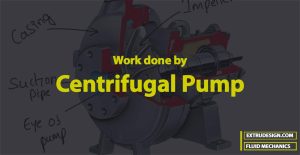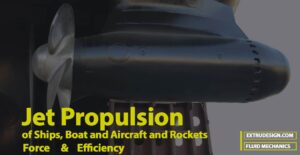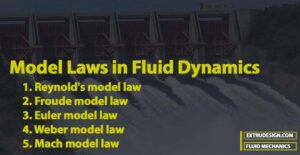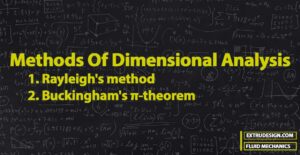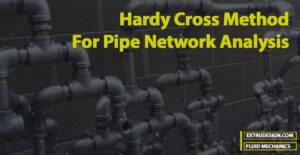The hydraulic machines, which convert the hydraulic energy into mechanical energy, are called turbines while the hydraulic machines which convert mechanical energy into hydraulic energy are called pumps. Hydraulic energy is in the form of pressure energy. If the mechanical energy is converted into pressure energy by means of centrifugal force acting on the fluid, […]

Fluid Mechanics is the branch of physics that deals with the behaviour of fluids (liquids, gases, and plasmas) and the forces on them. Fluid mechanics can be divided into two subfields fluid statics, which studies fluids at rest; and fluid dynamics, which studies fluids in motion. Fluid mechanics is based on several mathematical relationships that describe the kinematics, stress, conservation, regulation, and constitutive properties of fluids.
Hydraulic Machines are defined as those machines which convert either hydraulic energy (energy possessed by water) into mechanical energy (which is further converted into electrical energy ) or mechanical energy into hydraulic energy. The hydraulic machines, which convert the hydraulic energy into mechanical energy, are called turbines while the hydraulic machines which convert the mechanical energy into hydraulic energy are called pumps.
How does Centrifugal Pump Work?
The hydraulic machines, which convert the hydraulic energy into mechanical energy, are called turbines while the hydraulic machines which convert mechanical energy into hydraulic energy are called pumps. Hydraulic energy is in the form of pressure energy. If the mechanical energy is converted into pressure energy by means of centrifugal force acting on the fluid, […]
Governing of Turbines in Fluid Mechanics
Hydraulic machines are defined as those machines which convert either hydraulic energy (energy possessed by water) into mechanical energy (which is further converted into electrical energy ) or mechanical energy into hydraulic energy. The hydraulic machines, which convert the hydraulic energy into mechanical energy, are called turbines while the hydraulic machines which convert the mechanical […]
Characteristic curves of Hydraulic Turbines
Hydraulic machines are defined as those machines which convert either hydraulic energy (energy possessed by water) into mechanical energy (which is further converted into electrical energy ) or mechanical energy into hydraulic energy. The hydraulic machines, which convert the hydraulic energy into mechanical energy, are called turbines while the hydraulic machines which convert the mechanical […]
How to calculate Turbine Specific Speed?
Hydraulic machines are defined as those machines which convert either hydraulic energy (energy possessed by water) into mechanical energy (which is further converted into electrical energy ) or mechanical energy into hydraulic energy. The hydraulic machines, which convert the hydraulic energy into mechanical energy, are called turbines while the hydraulic machines which convert the mechanical […]
How to calculate the Efficiency of Draft Tube?
Hydraulic machines are defined as those machines which convert either hydraulic energy (energy possessed by water) into mechanical energy (which is further converted into electrical energy ) or mechanical energy into hydraulic energy. The hydraulic machines, which convert the hydraulic energy into mechanical energy, are called turbines while the hydraulic machines which convert the mechanical […]
Axial Flow Reaction Turbine | Kaplan Turbine
Hydraulic machines are those that convert either hydraulic energy (energy possessed by water) into mechanical energy (which is further converted into electrical energy ) or mechanical energy into hydraulic energy. The hydraulic machines, which convert the hydraulic energy into mechanical energy, are called turbines while the hydraulic machines which convert the mechanical energy into hydraulic […]
Radial flow Reaction Turbine – Parts, Work done, Efficiency
Hydraulic machines are those that convert either hydraulic energy (energy possessed by water) into mechanical energy (which is further converted into electrical energy ) or mechanical energy into hydraulic energy. The hydraulic machines, which convert the hydraulic energy into mechanical energy, are called turbines while the hydraulic machines which convert the mechanical energy into hydraulic […]
Pelton Turbine – Parts, construction, Working, Work done, Efficiency
Hydraulic machines are those that convert either hydraulic energy (energy possessed by water) into mechanical energy (which is further converted into electrical energy ) or mechanical energy into hydraulic energy. The hydraulic machines, which convert the hydraulic energy into mechanical energy, are called turbines while the hydraulic machines which convert the mechanical energy into hydraulic […]
Hydraulic Turbines – Heads, Efficiencies and Classification
Hydraulic machines are defined as those machines which convert either hydraulic energy (energy possessed by water) into mechanical energy (which is further converted into electrical energy ) or mechanical energy into hydraulic energy. The hydraulic machines, which convert the hydraulic energy into mechanical energy, are called turbines while the hydraulic machines which convert the mechanical […]
How to calculate Force and Efficiency of Jet Propulsion of Ships?
In Fluid Dynamics, A jet is a liquid stream projected into a surrounding medium or an object from the nozzle. Jet propulsion means the propulsion or movement of the bodies such as ships, aircraft, and rockets with the help of a jet. The reaction of the jet coming out from the orifice provided in the bodies is […]
How to Calculate Force Exerted by a Jet on a Series of curved Vanes?
A Nozzle is the portion of the pipe where the cross-sectional area varies from larger diameter to smaller diameter, and it can be used to direct or modify the flow of a fluid. A jet is a liquid stream projected into a surrounding medium or an object from the nozzle. This article will discuss How we can Calculate […]
How to Calculate Force Exerted by Jet on Moving Object?
A Nozzle is the portion of the pipe where the cross-sectional area varies from larger diameter to smaller diameter, and it can be used to direct or modify the flow of a fluid. A jet is a liquid stream projected into a surrounding medium or an object from the nozzle. In this article, we will discuss the force […]
How to Calculate the Force Exerted by Jet on Stationary Objects?
A Nozzle is the portion of the pipe where the cross-sectional area varies from larger diameter to smaller diameter, and it can be used to direct or modify the flow of a fluid. A jet is a liquid stream projected into a surrounding medium or an object from the nozzle. In this article, we will discuss […]
Model Laws in Fluid Mechanics | Dimensionless Numbers
In continuation with the previous article, Model Analysis in Fluid Mechanics helps predict the performance of these hydraulic structures or hydraulic machines before actually constructing or manufacturing. Model law helps identify the dynamic similarities between the model and the prototype. Let us discuss more details on different Model Laws in Fluid Dynamics. Dimensional Analysis and Model […]
Model Analysis in Fluid Dynamics
In Fluid Mechanics, Dimensional Analysis and Model Analysis are two important tools to help engineers to build structures or machines which involve hydraulic fluid. Model analysis especially helps predict the performance of these hydraulic structures (such as dams, spillways etc.) or hydraulic machines (such as turbines, pumps etc.), before actually constructing or manufacturing. In the […]
What are the Methods Of Dimensional Analysis?
Dimensional analysis is a method of dimensions. It is a mathematical technique used in research work for design and for conducting model tests. There are two different methods of Dimensional analysis. The first one is Rayleigh’s method and Buckingham’s π-theorem. In this article, let us discuss more details on these methods of Dimensional Analysis. Dimensional […]
Hardy Cross Method Procedure For Pipe Network Analysis
In the previous article, we discussed the Continuity equation, and the rate of flow discharge In Fluid Mechanics, the hardy cross method is used to analyse the Pipe network with help of a continuity equation. Pipe Network A pipe network is an interconnected system of pipes forming several loops or circuits. The pipe network is […]
What causes Water Hammer In Pipes?
In Fluid Mechanics, a Water Hammer is a most seen phenomenon that can occur in any piping system where valves are used to control the flow of liquids or steam. Let us discuss the different causes of Water hammering and the different outcomes of Water Hammering. Water Hammer in Pipes A water hammer is the […]
How to calculate Power Transmission Through Nozzles?
In Fluid mechanics, we have discussed Power Transmission Through Pipes in the previous article. We also discussed energy losses of fluid flow through pipes and studied the Viscous fluid flow in the pipe. In this article, let us see how to calculate the Power Transmission Through Nozzles and the maximum efficiency conditions for the flow of fluid through nozzles. […]
